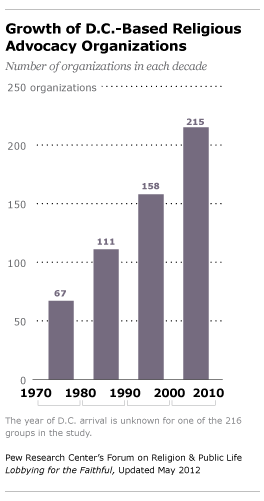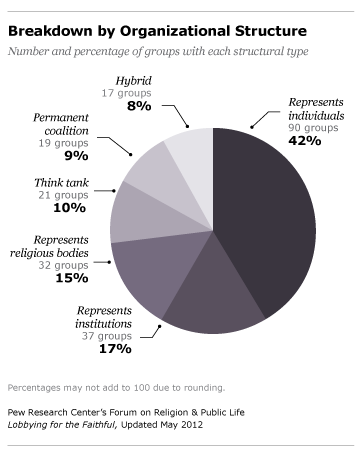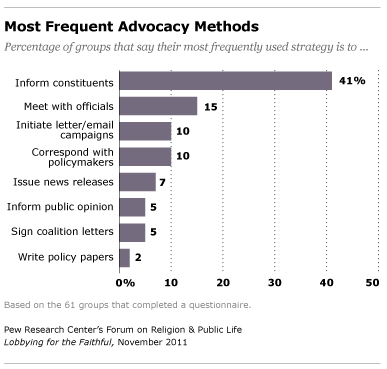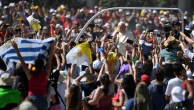Updated May 15, 2012
Executive Summary
Navigate this page:
The number of organizations engaged in religious lobbying or religion-related advocacy in Washington, D.C., has increased roughly fivefold in the past four decades, from fewer than 40 in 1970 to more than 200 today. These groups collectively employ at least 1,000 people in the greater Washington area and spend at least $350 million a year on efforts to influence national public policy. As a whole, religious advocacy organizations work on about 300 policy issues. For most of the past century, religious advocacy groups in Washington focused mainly on domestic affairs. Today, however, roughly as many groups work only on international issues as work only on domestic issues, and nearly two-thirds of the groups work on both. These are among the key findings of a new study by the Pew Research Center’s Forum on Religion & Public Life that examines a total of 216 religion-related advocacy groups operating in the nation’s capital.
The study finds that about one-in-five religious advocacy organizations in Washington have a Roman Catholic perspective (19%) and a similar proportion are evangelical Protestant in outlook (18%), while 12% are Jewish and 7% are mainline Protestant. But many smaller U.S. religious groups, including Baha’is, Buddhists, Hindus, Muslims and Sikhs, also have established advocacy organizations in the Washington area. In fact, the number of Muslim groups (17) is about the same as the number of mainline Protestant groups (16). And the largest category today is interreligious: About one-quarter of the groups studied (57) either represent multiple faiths or advocate on religious issues without representing a specific religion.
This report is based on a systematic examination of the websites, mission statements, tax documents and other public records of religious advocacy groups. Researchers also relied on responses to a written questionnaire that was sent to 148 separate, active groups included in the study and completed by 61 of them. Additionally, lead researcher Allen D. Hertzke conducted in-depth interviews with leaders of 36 groups and observed the advocacy efforts of many other groups at congressional hearings, lobby days, press conferences and other Washington-based events.

Previous studies indicate that lobbying in general has increased rapidly in recent decades. But the growth in the number of religion-related advocacy organizations appears to have kept pace with – or even exceeded – the growth in some other common types of advocacy organizations. According to various studies, for example, the number of national trade and professional associations more than doubled, from about 10,000 to about 22,000, between 1968 and the mid-1990s, then leveled off. And the number of corporations with Washington, D.C., offices rose more than threefold, from 175 to more than 600, between 1978 and 2004.2
Expenditures by Religious Advocacy Groups
Efforts by religious groups to influence U.S. public policy are a multimillion-dollar endeavor, with combined annual expenditures conservatively estimated at more than $350 million. The median annual advocacy expenditures by the 129 groups for which recent (2008 or 2009) financial data were available was nearly $950,000. More than one-third of the groups (44 groups, or 34%) reported annual advocacy expenditures between $1 million and $5 million per year, while about one-in-ten (17 groups, or 13%) reported spending more than $5 million a year. (See chart on Advocacy Expenditures.)
The recession in the U.S. economy from late 2007 to mid-2009 seems to have taken a toll on the budgets of many religion-related advocacy organizations. For instance, the executive secretary of the Friends Committee on National Legislation reported in June 2009 that the group’s advocacy spending dropped from $4.6 million to roughly $3 million between 2007 and 2009, primarily because of declining investments.

Of the 102 groups for which data on expenditures in both 2008 and 2009 were available, 57 reported that their advocacy spending was lower in 2009 than it had been in 2008. The average decline for the 57 groups was about $500,000. In the same period, 45 groups reported that their advocacy spending rose, with the average increase being about $300,000. Overall, among the 102 groups, there was a net drop of about $17 million in total advocacy expenditures during this period. (For more details, see Two-Year Comparison of Advocacy Spending subsection.)
Diversity in Religious Advocacy
Religious advocacy organizations in Washington reflect the pluralism of religion in America. They are diverse in many other ways as well, including in their organizational structures, their issue agendas and their primary advocacy methods.
Faith Communities: Roman Catholic, Protestant and Jewish advocacy groups are the most numerous (a total of 124 groups); together they make up 57% of the religious advocacy groups in the study. About one-in-six of the advocacy groups in the study (35 groups, or 16%) represent faiths with smaller numbers of adherents in the U.S., such as Baha’is, Buddhists, Hindus, Muslims and Sikhs, as well as other Christian and secular groups. The remaining quarter of the groups in the study (57) represent the views of multiple faiths or advocate on religion-related issues without representing a specific religious tradition, which is more than the number of groups representing any single faith.

Organizational Structure: Religious advocacy groups also exhibit a variety of organizational structures. Many groups represent individual members (90 groups, or 42%). These include, for example, Concerned Women for America, the American Israel Public Affairs Committee, Sojourners and People For the American Way. But a substantial portion are associations that represent institutions such as Christian colleges, Catholic hospitals and religious broadcasters (37 groups, or 17%). A similar number (32 groups, or 15%) represent the official interests of a particular denomination or religious tradition, such as the Justice and Witness Ministries of the United Church of Christ and the Ethics & Religious Liberty Commission of the Southern Baptist Convention. Still others (21 groups, or 10%) are think tanks, such as the Institute on Religion & Democracy and the Jewish Institute for National Security Affairs. Permanent coalitions — such as the Save Darfur Coalition, which focuses on Sudan, and the Jubilee USA Network, which seeks debt relief for poor countries — account for 19 groups, or 9% of the total. Hybrid groups that cross over various categories — such as the Becket Fund for Religious Liberty, which combines elements of a think-tank with a public interest law firm — make up the remainder (17 groups, or 8%).
Issue Agendas: This study finds that religious advocacy groups in Washington address about 300 policy issues, touching on a wide array of domestic and foreign policy concerns. A fifth of the groups focus just on domestic matters, while about one-in-six (16%) focus solely on international issues. Nearly two-thirds (63%), however, are engaged in both domestic and foreign issues.

On the domestic front, the most commonly addressed issues are the relationship between church and state, the defense of civil rights and liberties for religious and other minorities, bioethics and life issues (such as abortion, capital punishment and end-of-life issues) and family/marriage issues (such as the definition of marriage, domestic violence and fatherhood initiatives).

Internationally, the most commonly addressed concerns are human rights, debt relief and other economic issues, and the promotion of peace and democracy. Indeed, compared with past decades, religious advocacy today is increasingly globalized, connecting a multitude of diverse constituencies with policymakers in the United States and other countries.
Advocacy Methods: More than nine-in-ten groups that completed a questionnaire about their activities say that informing their constituents and the general public is among their advocacy methods or strategies. (For more information on the questionnaire, see the Methodology.) And about four-in-ten of the groups that filled out the questionnaire (41%) report that educating constituents on issues – rather than directly approaching policymakers — is the activity they engage in most often. The next most-cited strategy is meeting with officials, which 15% of the groups list as their most frequent activity.
Other findings in the study include:
- More than eight-in-ten of the 216 religious advocacy groups in the study (82%) operate as nonprofit, tax-exempt organizations under Section 501(c)(3) of the Internal Revenue Code. This means they are not allowed to devote a substantial part of their activities to lobbying as defined by the Internal Revenue Service.
- Only 10 groups (5%) are organized solely as 501(c)(4) organizations, which are permitted to conduct substantial amounts of lobbying as defined by the IRS. Twenty-seven groups (13%) are 501(c)(3) organizations that have a sister group that is registered as a 501(c)(4), or vice versa.
- While more than three-quarters of American adults identify as Christians, about half of the religious advocacy groups in the study are exclusively Christian. Many of the religious coalitions and interreligious groups, however, are partly or largely Christian in outlook.
- More than eight-in-ten of the groups that completed a questionnaire about their activities say they use targeted or mass emails to mobilize constituents. More than six-in-ten were using social networking tools such as Facebook and Twitter in 2009.
- Eight-in-ten of the groups for which staffing data were available employ 12 or fewer people in the Washington area.
Religious advocacy is broadly defined in this study to encompass a wide range of efforts to shape public policy on religion-related issues. It includes lobbying as strictly defined by the Internal Revenue Service – attempts to influence, or urge the public to influence, specific legislation, whether the legislation is before a legislative body, such as the U.S. Congress or any state legislature, or before the public as a referendum, ballot initiative, constitutional amendment or similar measure.* But it also includes other efforts to affect public policy, such as activities aimed at the White House and federal agencies, litigation designed to advance policy goals, and education or mobilization of religious constituencies on particular issues. The issues may range from inherently religious matters (such as promotion of religious freedom and support for parochial schools) to social and political issues on which religious groups seek to promote their perspectives (such as abortion, same-sex marriage, hunger and HIV-AIDS).
The Organizations that engage in religious advocacy in Washington include many groups that come out of particular religious traditions, such as Catholic Charities USA, the American Jewish Committee and the Muslim American Society. They also include organizations that do not represent a particular faith but nonetheless have predominantly religious constituencies or advocate on public issues from a religious perspective, such as the National Right to Life Committee and the National Coalition to Abolish the Death Penalty. In addition, they include groups that seek to influence public policy from a clearly articulated non-religious perspective (often in opposition to religious groups), such as the American Humanist Association and the Secular Coalition for America.
This study focuses on the efforts of national groups, meaning those that seek to influence policymaking at the federal level, though many of these groups also are active at the state or local level, and some are international in scope. To keep the focus on national advocacy, the study is limited to organizations that maintain a permanent advocacy office and at least one paid employee in the greater Washington, D.C., area. (See Methodology for more details.)
* For more information, see Internal Revenue Service, Lobbying, http://www.irs.gov/charities/article/0,,id=163392,00.html. (return to text)
This report is based on the full set of 216 groups except where otherwise indicated. For example, the discussion of the groups’ advocacy strategies is based primarily on the 61 groups in the study that completed the questionnaire. (See the Methodology for details.)
Readers should bear three important limitations in mind. First, although this study analyzes a number of major characteristics of religious advocacy organizations, including their annual spending, it does not attempt to assess their political influence. An organization’s size – whether measured by expenditures, staff size or number of constituents – is not necessarily a reliable indicator of its influence on policymaking. This study makes no claims about the degree of influence wielded either by individual organizations or by religious advocacy groups as a whole.
Second, religious advocacy undoubtedly is conducted, formally and informally, by many individuals and groups beyond the 216 organizations included in this report. Numerous other religious groups send delegations to the nation’s capital, organize campaigns from a distance, join coalitions and contact legislators in their home districts as well as in Washington. For example, the American Family Association, based in Mississippi, operates an extensive legislative alert system that identifies legislation relevant to its members and urges them to contact lawmakers, but it does not have a Washington office. This study focuses on formal, institutional efforts by groups with paid staff and physical offices in or near the nation’s capital. Given the limits of the study, it is likely that the findings reported here underestimate the full breadth and depth of religious advocacy in Washington.
Finally, the groups define themselves in many different ways, and they report their expenditures, constituencies, issue agendas and other characteristics differently. Professor Hertzke and Pew Forum researchers have tried to be as consistent as possible in determining how to categorize the advocacy groups. The study relies primarily on the groups’ own websites, mission statements and tax filings, as well as questionnaire and interview responses, to determine what issues they work on, what strategies they employ, what constituencies they represent, how many staff members they have and how much they spend on advocacy. However, judgment calls inevitably had to be made, and other researchers might have made different decisions. For this reason, the study tries to be as transparent as possible. For example, the study includes an online table showing the spending data that was considered in determining which expenditures most closely reflect each group’s annual advocacy-related spending. Professor Hertzke and the Pew Forum researchers tried to choose the expenditure figures for each group that best reflected the broad definition of advocacy used in this report. Given the broad range of advocacy activities that many of the groups undertake, the study does not restrict the expenditures to those costs that were incurred for direct lobbying as strictly defined by the Internal Revenue Service. (See Methodology for more details.)
The next section of this report provides a brief history of organized religious advocacy in Washington – “Evolution, Growth and Turnover.” This is followed by an analysis of the major characteristics of religious advocacy groups currently or recently active in the nation’s capital. The order of the sections is as follows:
- Brief history of religious advocacy in Washington
- Religious tradition or denomination
- Organizational structure
- Tax status
- Advocacy expenditures
- Issue agendas
- Constituency size
- Staff and facilities
- Strategies
In addition, an online directory includes profiles of the 216 religious advocacy groups in the study, as well as excerpts from their mission statements and financial data, where available.
Footnotes:
2 For an overview of these studies, see Berry and Wilcox, “The Advocacy Explosion” in The Interest Group Society, 2009. In addition, the Center for Responsive Politics reports that the number of registered lobbyists grew from about 10,400 in 1998 to nearly 15,000 in 2007, before dropping to around 13,000 in 2010. Total estimated lobbying spending has more than doubled over the same period, rising from $1.44 billion in 1998 to $3.51 billion in 2010. See Center for Responsive Politics, http://www.opensecrets.org/lobby/.(return to text)




